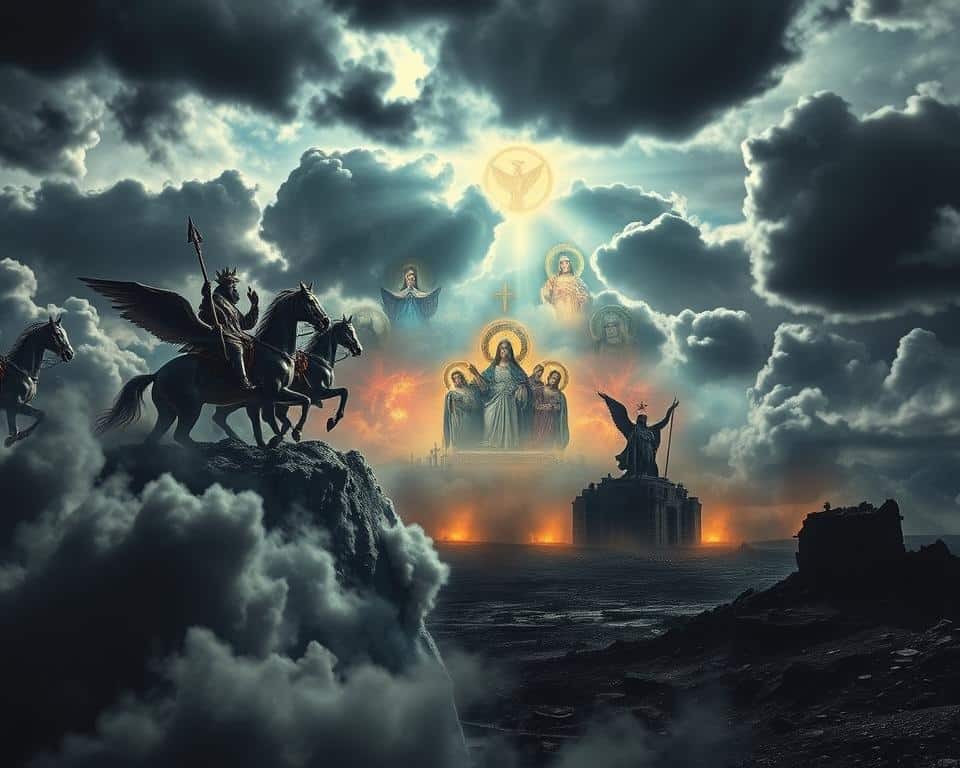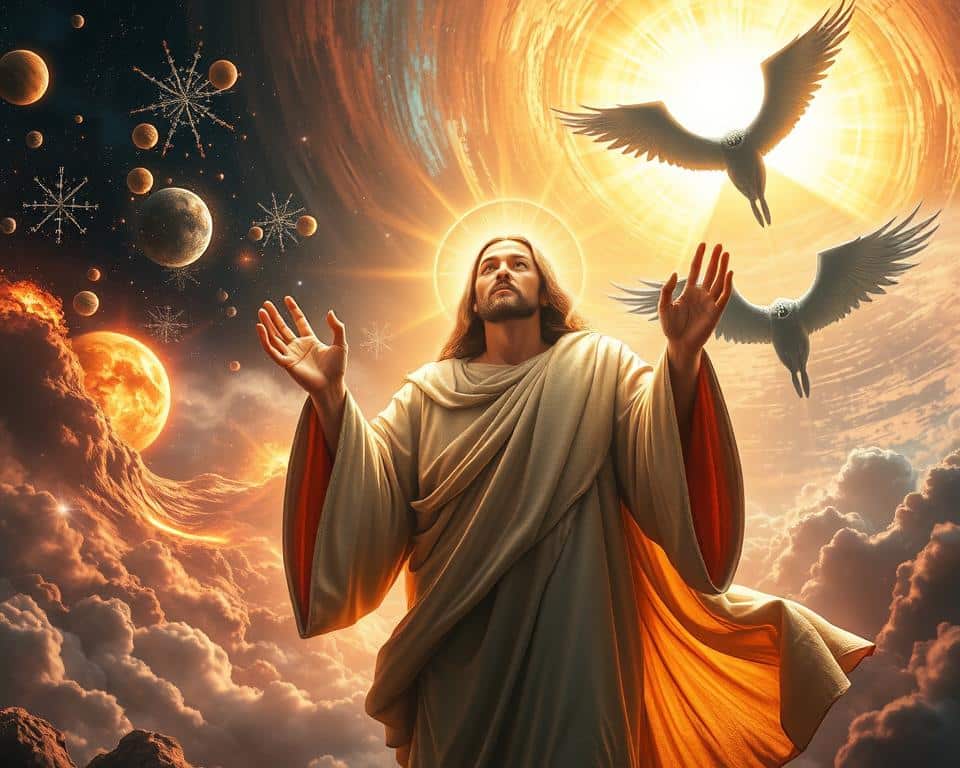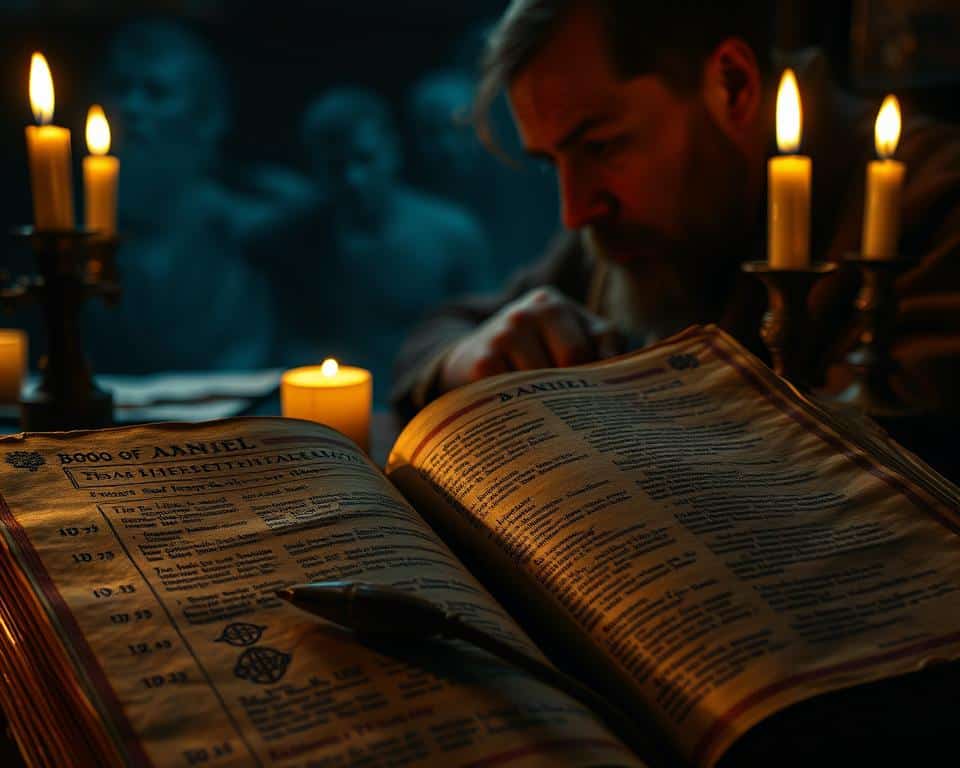The Book of Revelation is filled with vivid imagery that can feel overwhelming at first glance. Yet, these powerful visions hold deep truth for those who seek understanding. As Joseph Smith once said, it’s “one of the plainest books God ever caused to be written”—when viewed through the right lens.
Many readers today struggle with its surreal language. Without historical and biblical context, the message can seem unclear. But Scripture itself provides keys to unlock its meaning.
This article will help you grasp the divine truths behind its imagery. By exploring God’s word and trusted insights, you’ll see how Revelation speaks clearly to our faith today.
Understanding Revelation’s Symbolic Language
John’s coded messages in Revelation were designed for persecuted believers. Facing Roman oppression, he used vivid imagery to share hope-filled truth without alerting hostile authorities. Symbolic language became a lifeline for early Christians—a divine message veiled in metaphor.
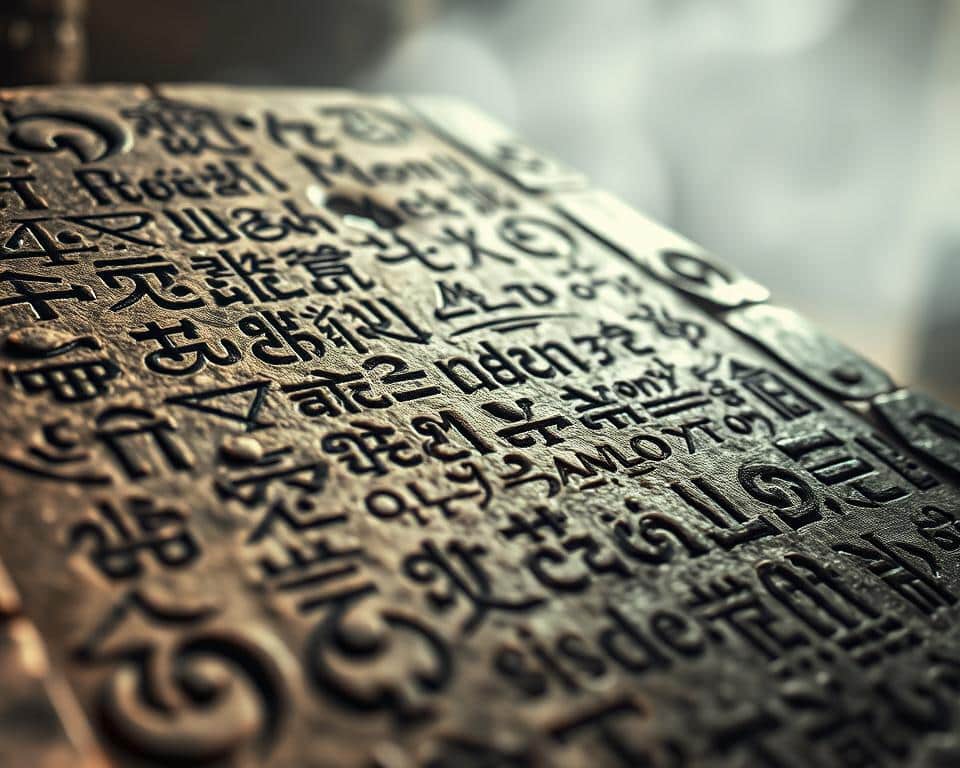
Why Symbolic Imagery Was Essential
Rome’s censorship forced John to write discreetly. Like Old Testament prophets, he drew on familiar symbols to bypass corruption. For example:
- The dragon represented Satan, echoing Jewish apocalyptic texts.
- Numbers like 7 signaled completeness, a pattern early believers understood.
“The book proceeded from God in the days of the apostles, and was never altered.”
How Early Christians Decoded the Message
John’s original audience recognized his references. Revelation 17:15 clarifies “waters” as nations—showing Scripture defines its own terms. The churches cherished this book’s imagery because it echoed their faith’s foundations.
Today, we unlock these same truths by studying God’s word in context. What once shielded believers now reveals timeless hope.
The Meaning of Numbers in Revelation
Numbers in Scripture often carry deeper significance than their face value. They form a divine language that reveals God’s perfect design. When you understand their patterns, biblical visions become clearer.
7: Completeness and perfection
The number seven appears throughout Scripture as God’s signature of wholeness. In Revelation, we see seven churches, seals, trumpets, and bowls. Each set represents complete divine action.
This pattern echoes creation—seven days forming a perfect cycle. When John writes to seven churches, he addresses all believers across time.
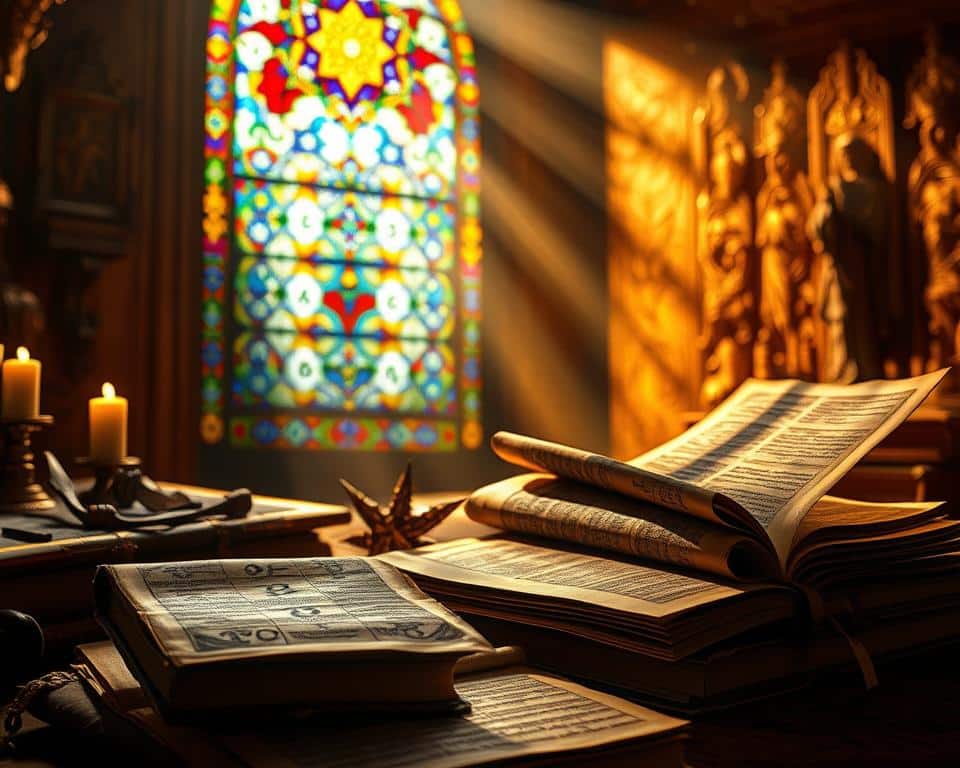
12: God’s people and authority
Twelve signals divine governance. It connects to Israel’s twelve tribes and Christ’s twelve apostles. Revelation’s New Jerusalem has twelve gates and foundations—showing God’s eternal kingdom.
This number reminds us: God’s promises endure through generations. His authority remains unchanging.
“Seven represents divine fullness—the complete work of God in creation and redemption.”
3½: Limited time of suffering
This broken seven appears as 42 months or 1,260 days. It symbolizes evil’s temporary rule before God intervenes. Like Daniel’s prophecy, it assures believers: persecution has an expiration date.
Though darkness seems strong now, its time is measured. God remains sovereign over history.
666: The number of the beast
This infamous number represents ultimate rebellion against God. Early Christians likely recognized it as code for Roman emperors claiming divinity. The beast‘s incomplete six (versus God’s perfect seven) shows its doomed nature.
Today, it warns against any power opposing Christ. But take heart—evil’s defeat is certain.
When you see these numbers in Scripture, remember: God speaks through patterns. Every digit points to His perfect plan unfolding in our world.
Color Symbolism in Revelation
Colors in Scripture often carry divine messages beyond their visual appearance. In Revelation, hues like white, red, and black aren’t just descriptive—they reveal God’s perspective on faith, judgment, and hope. Let’s explore their deeper meanings.
White: Purity and Victory
White robes symbolize righteousness throughout Scripture. In Revelation 3:5, Christ promises believers will wear white garments—a sign of His victory over sin. Martyrs in Revelation 6:11 are given white robes, showing God’s approval even in death.
This color also points to Christ’s authority. His hair “white like wool” (Revelation 1:14) reflects wisdom and divine glory. When you see white, think: God’s purity covers His people.
Red: War and Bloodshed
Red carries dual meanings. The red horse (Revelation 6:4) represents war, echoing the dragon’s violence. Yet red also reminds us of Christ’s sacrifice—His blood bringing life to repentant hearts.
This contrast teaches a vital truth: earthly conflict is temporary, but Christ’s redemption lasts forever.
Black: Famine and Death
The black horse rider holds scales, signaling economic collapse (Revelation 6:5–6). Black warns of scarcity—a consequence of rebellion against God. But remember: even famine serves God’s purpose. It calls humanity back to dependence on Him.
Pale Green: Decay and Plague
This sickly hue mirrors earth’s brokenness. The pale horse (Revelation 6:8) brings plague, echoing Exodus’ judgments. Yet God limits suffering—His mercy endures amid judgment.
Revelation’s symbolism isn’t arbitrary. Each color points to God’s character and His plan for creation. Look beyond the surface, and you’ll find timeless truth.
Key Creatures and Their Meanings
God communicates His divine plan through symbolic creatures in biblical prophecy. These figures—like the Lamb and the dragon—reveal spiritual battles and divine victories. Understanding them helps us grasp God’s truth for today.
The Lamb: Jesus Christ
The Lamb stands at the center of John’s vision (Revelation 5:6). Its imagery echoes Passover, where lambs saved Israel from death. Here, Christ’s sacrifice becomes the ultimate deliverance.
Seven horns show His complete power. Eyes symbolize divine wisdom. Unlike earthly rulers, the Lamb conquers through love, not force.
“The Lamb’s victory isn’t political—it’s redemptive. His scars declare mercy triumphs over judgment.”
The Dragon: Satan
This fiery serpent embodies chaos (Revelation 12:3). Seven heads parody God’s perfection, likely representing Rome’s seven hills. Ten horns signal temporary power.
Though fierce, the dragon’s fate is certain. Revelation 20:10 shows his defeat. Today, he still accuses God’s people—but Christ’s victory shields us.
The Beast: Anti-Christian Powers
Two beasts arise in Revelation 13. The sea beast mirrors oppressive empires like Rome. The earth beast deceives through false worship—a warning against compromising faith.
- Political power (sea beast) demands loyalty.
- False religion (earth beast) mimics truth.
Both fall before the Lamb. Their 666 mark contrasts God’s seal (Revelation 14:1).
The Four Living Creatures: Divine Attributes
These beings reflect God’s nature (Revelation 4:6–8). Their faces—lion, ox, man, eagle—mirror Ezekiel’s vision. Together, they show:
- Strength (lion)
- Service (ox)
- Wisdom (man)
- Heavenly perspective (eagle)
Their endless worship reminds us: God’s glory fills all creation.
Revelation’s Symbols and Meanings of Objects
From sealed scrolls to golden bowls, biblical visions use physical items to convey heavenly realities. These objects aren’t random—they reveal God’s authority and His timeline for humanity. When you understand their purpose, Scripture’s message becomes clearer.
Scrolls and Books: God’s Plans
The sealed book in Revelation 5 holds God’s hidden will. Only the Lamb—Christ—is worthy to open it. This echoes Daniel’s sealed prophecy (Daniel 12:4), now unlocked in Jesus.
Later, John eats an open book (Revelation 10:9–10). Sweet yet bitter, it symbolizes proclaiming God’s truth despite persecution. Both scrolls show divine wisdom unfolding in stages.
Seals: Divine Authorization
Broken seals release God’s sequential plan (Revelation 6:1–17). Each reveals a facet of His purpose, from conquest to justice. As Draper notes, they represent “hidden truths now disclosed” (D&C 77:6).
The Lamb’s role is key. His sacrifice authorizes Him to open what no one else can. This reminds us: Christ alone holds ultimate authority.
Trumpets: Warnings and Announcements
Seven trumpets echo Exodus’ plagues (Exodus 19:16–19). They signal partial judgment, urging repentance. Like ancient Israel, we’re called to heed God’s warnings.
WordBytes connects trumpets to new beginnings. Even in discipline, God’s mercy shines. His goal isn’t destruction—it’s redemption.
Bowls: Judgments Poured Out
Golden bowls (Revelation 16:1–21) represent final wrath. Unlike trumpets, their effects are total. Yet they target rebellion, not the faithful. God’s justice ensures evil won’t prevail.
“The bowls remind us: sin’s reign has an end. Christ’s victory is certain.”
Every object points to the throne. Scrolls, seals, trumpets, bowls—all flow from God’s sovereign rule. They assure us: His plan is perfect, and His timing is right.
Symbolic Locations in Revelation
Locations in biblical prophecy carry deep theological significance. John’s visions contrast earthly corruption with God’s eternal kingdom. These places aren’t just settings—they reveal His plan for humanity.
New Jerusalem: God’s Kingdom
The New Jerusalem descends as a radiant city (Revelation 21:2). Its twelve gates bear the names of Israel’s tribes, while foundations honor Christ’s apostles. This place symbolizes unity—God’s people across nations and time.
Streets of gold and a river of life show God’s provision. Unlike earthly cities, it needs no temple—the Lamb is its light.
Babylon: Worldly Corruption
Babylon represents oppressive systems (Revelation 18:11–13). WordBytes links it to ancient Rome, but its greed echoes today. Luxury trades—gold, spices, slaves—expose exploitation.
Her fall warns against valuing the world over God. Yet hope remains: “Come out of her, my people” (Revelation 18:4).
Armageddon: Final Conflict
Armageddon recalls Megiddo’s historic battles. Here, it symbolizes the ultimate clash between good and evil. Scripture clarifies: this isn’t a literal place but a spiritual turning point.
Christ returns not with armies, but truth (Revelation 19:11–16). The battle ends with His word.
The Throne: God’s Authority
John’s throne visions (Revelation 4) center on worship. Heavenly creatures declare God’s holiness day and night. Rainbow hues reflect His covenant faithfulness.
“The throne isn’t about power—it’s about relationship. God reigns to redeem.”
Babylon’s fall contrasts Jerusalem’s descent. One collapses under greed; the other brings God’s presence. Both visions point to a choice: temporary world or eternal life.
The Four Horsemen and Their Meanings
Four riders emerge in biblical prophecy, each carrying a divine message about humanity’s journey. As the Lamb breaks the seals in Revelation 6, these horsemen reveal God’s measured response to a broken earth. Their progression—from conquest to death—shows escalating trials, yet Christ’s victory overshadows them all.
White Horse: False Conquest
The first rider wears a crown, wielding a bow (Revelation 6:2). His white horse mimics purity but carries deception. Scholars link him to false messiahs—those claiming power in God’s name (Matthew 24:5). This rider reminds us: not all that glitters is divine.
Red Horse: Violent Conflict
Next comes war, symbolized by a fiery steed (Revelation 6:4). The rider’s sword reflects global strife, from ancient battles to modern tensions. Yet Scripture assures: such chaos is temporary. God permits conflict for a time, but His peace will reign.
Black Horse: Economic Oppression
This rider holds scales, signaling famine (Revelation 6:5–6). WordBytes notes the denarius wage—barely enough for bread. The black horse’s way exposes greed’s cost: when resources hoarded, the poor suffer. Even here, God sets limits.
Pale Horse: The Shadow of Death
The final horse’s sickly hue mirrors plague and death (Revelation 6:8). Hades follows, yet believers need not fear. As Draper explains, these judgments purify; they’re not God’s last word. The Lamb’s resurrection outshines the grave.
“The horsemen aren’t about doom—they’re about God’s patience. Each seal delays the final judgment, urging repentance.”
Together, these riders depict a world groaning for redemption. But take heart: their gallop has an end. The power of Christ’s return will silence every threat, restoring creation’s balance.
Symbolic Clothing in Revelation
Garments in Scripture often mirror the condition of the heart. In biblical prophecy, what we wear reflects our standing before God—either cleansed by His grace or stained by sin. These divine dress codes reveal timeless truths for His people.
White Robes: Washed in Righteousness
White robes symbolize purity through Christ’s sacrifice. Revelation 7:14 shows saints who “washed their robes” in His blood—echoing baptismal covenants. WordBytes connects this to resurrection, where God’s word transforms us.
Overcomers receive white garments (Revelation 3:5), a promise of eternal life. Like wedding attire in Matthew 22:11–14, they show readiness for Christ’s return.
Golden Sashes: Royal Priesthood
Christ wears a golden sash (Revelation 1:13), marking His dual role as King and High Priest. Trietsch notes this signifies authority—a model for the church’s calling. Believers share this priesthood, serving as “a kingdom of priests” (Revelation 5:10).
“Golden sashes remind us: our worth comes from Christ’s victory, not worldly status.”
Soiled Garments: The Danger of Lukewarm Faith
Laodicea’s “soiled clothes” (Revelation 3:16–18) warn against half-hearted devotion. Unlike white robes, these stains reveal self-reliance. Yet God offers cleansing—the way to victory lies in repentance.
Every garment in prophecy points to a choice: cling to sin or embrace Christ’s righteousness. The clothing we “wear” today prepares us for eternity.
The Two Witnesses Symbolism
Two figures stand at the heart of God’s final warning. Clothed in sackcloth, they embody faithfulness amid opposition. Their story isn’t just ancient history—it’s a blueprint for God’s people today.
Olive Trees: Anointed Ones
Revelation’s witnesses are called “two olive trees” (Revelation 11:4), echoing Zechariah’s vision. In Zechariah 4:14, olive trees represent “anointed ones”—leaders filled with God’s Spirit. These witnesses carry divine power, just as oil fuels lamps.
Their roles mirror Moses and Elijah. Like Moses, they strike the earth with plagues. Like Elijah, they shut the sky (Revelation 11:6). This duality confirms God’s word through unified testimony.
Lampstands: Light Bearers
The witnesses also symbolize lampstands—congregations shining truth. WordBytes connects this to churches upholding Scripture. Their light isn’t their own; it reflects Christ, the true Lamp (John 8:12).
Their 3½-year ministry mirrors Christ’s timeline. This limited time signals urgency. Yet even in death, their resurrection stuns observers (Revelation 11:11). Evil’s victory is short-lived.
“The two witnesses represent God’s relentless call to repentance—His mercy woven into judgment.”
Together, these things reveal God’s pattern: He sends truth-bearers before decisive moments. The witnesses’ fate—and triumph—point to His ultimate plan.
The Mark of the Beast Explained
A choice between divine and earthly allegiance defines biblical prophecy’s central conflict. Revelation contrasts God’s seal with the beast’s mark—a visible divide in ultimate loyalty.
Forehead Seals vs. Hand Marks
God’s faithful receive forehead seals (Revelation 7:3), symbolizing wholehearted devotion. This echoes Deuteronomy 6:8, where God’s truth binds to thought and action.
The beast’s mark appears on hands or foreheads (Revelation 13:16). Hand placement suggests forced compliance—actions without heart conviction. Forehead marks mimic true worship but lack surrender.
Decoding 666’s Ancient Warning
Early Christians recognized 666 as Nero’s name in Hebrew numerology. Richard Draper notes: “Gematria exposed oppressive rulers masking as gods.” This beastly number still warns against systems demanding ultimate allegiance.
WordBytes connects the mark to economic control—buying/selling restrictions. Like Rome’s currency bearing emperor’s images, it tests whom we truly value.
Modern Parallels and Eternal Choices
Today’s digital IDs and coercive policies echo John’s vision. Yet the core issue remains: Will people compromise faith for convenience?
“The mark isn’t about technology—it’s about worship. God’s seal guards those who choose His way.”
Revelation’s contrast assures: earthly powers fade. God’s sealed people stand secure in Christ’s victory.
The Woman and Child Vision
A cosmic battle unfolds in Revelation’s most vivid vision. A radiant woman, a triumphant child, and a furious dragon collide in a scene that reveals God’s care for His people. This isn’t mythology—it’s divine truth wrapped in prophetic imagery.
The Woman: God’s Faithful Community
The woman clothed with the sun represents God’s covenant family (Revelation 12:1-2). Richard Draper identifies her as both Israel and the church—those who nurture the Messiah’s lineage. Her crown of twelve stars echoes Joseph’s dream, linking past promises to future hope.
The Child: Christ’s Victorious Rule
Her male child wields an iron scepter (Psalm 2:9), a symbol of Christ’s authority. Though the dragon waits to devour Him, the cross becomes Satan’s defeat. The child’s ascension proves no earthly power can thwart God’s plan.
“Calvary wasn’t Satan’s victory—it was his undoing. The resurrection sealed his fate.”
Wilderness Refuge: Divine Protection
When persecuted, the woman flees to safety (Revelation 12:14). This wilderness shelter mirrors God’s care for Elijah and Israel. Today, it reminds us: even in trials, He prepares a way.
This vision isn’t just history—it’s your story. Like the woman, you’re called to shine Christ’s light in a dark world. And like the child, your hope rests in His unshakable victory.
Heavenly Beings and Their Roles
Celestial figures in biblical prophecy reveal God’s divine order and purpose. These beings aren’t mythical—they show how heaven operates. You’ll notice each has specific duties that advance God’s plan.
The 24 Elders: Redeemed Humanity’s Voice
Twenty-four elders surround the throne, representing all believers (Revelation 4:10–11). WordBytes explains their dual symbolism: twelve tribes plus twelve apostles. Together, they embody God’s complete family across time.
Their golden crowns and white robes show victory through Christ. When they cast crowns before God, they acknowledge His ultimate authority. This scene gives us an eternal perspective—worship is our highest calling.
“The elders model perfected worship—humanity fully aligned with God’s will.”
Angels: Heaven’s Active Servants
Angels appear throughout Scripture as God’s messengers and executors. Some deliver hope, like Gabriel (Luke 1:19). Others enact judgments, like the trumpet-bearing angels (Revelation 8:2).
Michael the archangel leads heaven’s armies (Revelation 12:7). His name means “Who is like God?”—a reminder that no power rivals the Creator. God’s word affirms their protective role over believers (Psalm 91:11).
Four living creatures cry “Holy” day and night (Isaiah 6:3). Their ceaseless praise shows heaven’s priority. Even in executing judgments, angels point to God’s holiness.
At the end day, all heavenly beings direct attention to Christ. Their varied roles reveal one truth: God orchestrates all things for His glory and our good.
Tree of Life and Other Eden Symbols
The Tree of Life reappears in Scripture’s final pages as a promise fulfilled. Revelation 22:2 mirrors Genesis 2:9, showing God’s plan to restore what sin fractured. This isn’t just poetry—it’s a divine guarantee that His word never fails.
Restored Access to Paradise
Eden’s guarded tree (Genesis 3:24) symbolized humanity’s exile. But in New Jerusalem, the Tree of Life stands open to all (Revelation 22:14). Its twelve fruits signify God’s complete provision—monthly healing for every nation.
Leaves bring healing, echoing Ezekiel 47:12’s life-giving river. This isn’t mere metaphor. It’s God’s tangible renewal of all things—spiritual and physical. Baptism’s “water of life” foreshadows this eternal refreshment.
River of Life: God’s Provision
Crystal-clear water flows from God’s throne (Revelation 22:1), just as Eden’s river nourished the garden. Trietsch connects this to the Holy Spirit—always moving, always sustaining. Unlike earthly resources, this river never runs dry.
“The river and tree together show God’s way of restoration—not just returning to Eden, but surpassing it.”
Revelation’s Eden imagery contrasts the fallen world. Where Adam faced banishment, Christ welcomes us home. The Tree of Life isn’t just a symbol—it’s your invitation to eternal fellowship with God.
Common Misunderstood Symbols
Biblical prophecy often gets misinterpreted when taken too literally. Symbols like the 144,000 or 1,260 days aren’t math problems—they’re divine metaphors. When you grasp their deeper meaning, God’s plan becomes clearer.
144,000: Complete Number of Believers
The 144,000 isn’t a literal headcount (Revelation 7:4–8). Richard Draper explains it represents all faithful priesthood holders—the church throughout history. The twelve tribes symbolize God’s unified people, not an exclusive group.
WordBytes connects this to the “great multitude” in Revelation 7:9. Both versions describe the same redeemed community. One uses Jewish imagery; the other shows every nation. Together, they reveal God’s inclusive love.
Time Periods: Symbolic Not Literal
Numbers like 1,260 days (Revelation 12:6) signify a time of testing, not a calendar prediction. Early Christians facing Roman persecution understood this as their era’s struggles. The number echoes Daniel’s prophecies, showing evil’s limited reign.
Revelation 3:10’s “hour of trial” refers to global spiritual testing. Like Noah’s flood or Exodus plagues, it’s a season of discernment. God marks these periods to urge readiness, not fear.
“Date-setting contradicts Christ’s words: ‘No one knows the day or hour’ (Matthew 24:36). Focus on faithfulness, not calendars.”
Even the “new song” (Revelation 14:3) is symbolic—a fresh expression of praise only the redeemed can fully grasp. These visions aren’t puzzles to solve but truths to live by. When read through Scripture’s lens, their hope shines bright.
Applying Revelation’s Symbols Today
God’s prophetic visions still speak powerfully today. The symbols aren’t relics—they’re roadmaps for navigating trials with hope.
Discern modern “beast” systems like materialism or oppression. Like lampstand churches, shine truth in dark places. Stand firm when crises shake the world’s foundations.
Christ’s promise in Revelation 22:20 anchors our faith. He’s coming to restore all things. Until then, study Scripture prayerfully. Let it shape your daily life.
Want deeper guidance? Learn how to worship God in trials. His word lights the path forward.

